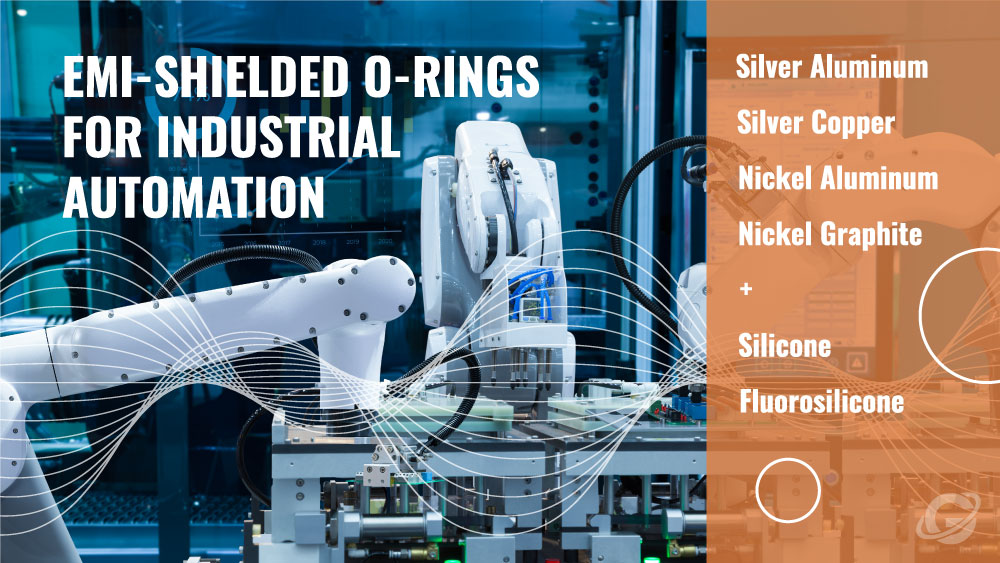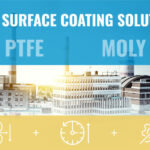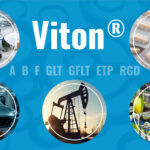
Summary
- Electromagnetic Interference (EMI) significantly impacts industrial automation. EMI-shielded o-rings provide crucial protection for electronic systems against disruptive electromagnetic disturbances and ensure operational reliability and precision.
- EMI-shielded o-rings, made from various specialized compounds, are essential across multiple industries. They offer unique properties like high conductivity, corrosion resistance, and environmental durability for diverse applications.
- Future advancements in EMI-shielded o-ring technology are critical as digital transformation in industries escalates. This requires innovative materials and designs to meet evolving demands for efficient, reliable EMI shielding.
Introduction to EMI-Shielded O-Rings in Industrial Automation
Electromagnetic Interference (EMI) is an invisible force that can disrupt, degrade, and impair the performance of electronic equipment and presents a significant challenge in industrial automation. Understanding EMI and its implications is crucial, especially in an area where technology and automation intertwine closely. EMI-shielded o-rings emerge as a vital component in this scenario. These specialized o-rings provide an effective barrier against the pervasive influence of EMI on sensitive electronic systems. Their role in industrial automation is increasingly critical, and their applications extend across various sectors of industrial automation. Emerging trends in using EMI-shielded o-rings also point towards a future where their relevance will only grow. This blog post provides a comprehensive understanding of EMI-shielded o-rings, exploring the complexities of EMI, the materials used in EMI-shielded o-rings, their diverse application, maintenance and troubleshooting, and the future outlook of this technology.
Understanding Electromagnetic Interference (EMI)
Electromagnetic Interference (EMI), a prevalent concern in industrial environments, refers to the disturbance generated by an external source that affects an electrical circuit through electromagnetic induction, electrostatic coupling, or conduction. This interference can disrupt, degrade, or even stop the operation of electronic equipment, making its control crucial in automated settings.
A key solution to combat EMI in such environments is specialized EMI-shielded o-rings. Unlike standard o-rings, designed primarily to prevent leaks of fluids or gases, EMI-shielded o-rings have an additional critical function to shield against electromagnetic interference. The basic composition of EMI-shielded o-rings integrates conductive materials, such as metal or metal-coated particles, into the elastomer. This unique blend enables them to serve as seals and conduits for grounding or blocking electromagnetic waves, thereby protecting sensitive electronic components.
The distinction between EMI-shielded o-rings and standard o-rings also extends to their application. While both types serve as seals, the EMI-shielded o-rings are essential in environments where electronic and electrical systems are vulnerable to electromagnetic disruptions. This application makes them indispensable in modern industrial automation, where precision and reliability are paramount.
The effects of EMI on equipment and processes in industrial automation can be profound. From causing data loss and signal disruption to damaging sensitive electronic components, EMI can lead to downtime, reduced efficiency, and increased maintenance costs. These effects underscore the importance of EMI control measures, like integrating EMI-shielded o-rings, to safeguard equipment and ensure smooth operation.
In response to these challenges, industries must adhere to various compliance and regulatory standards for EMI. These standards, varying by region and industry, dictate the permissible levels of electromagnetic emissions from equipment. Adhering to these regulations is fundamental to ensuring reliability and safety in automated systems.
Lastly, EMI control is significant in the context of industrial automation. Effective management of electromagnetic interference is essential with the increasing reliance on electronic systems and the growing complexity of industrial processes. EMI-shielded o-rings are vital in offering a straightforward, effective solution to a complex problem, ensuring that industrial automation systems function optimally without disruption from electromagnetic disturbances.
Materials Used in EMI O-Rings
EMI-shielded o-rings are vital in industrial automation for their ability to provide effective electromagnetic interference shielding. These o-rings are available in various compounds, each tailored to meet the specific requirements of diverse industrial settings. Below is a comprehensive overview of the common materials used in EMI-shielded o-rings.
| Compound Name | Compound Composition | Cost | Durometer | MAX VR | MIN Shielding Effectiveness 20 MHZ to 10 GHZ (MIL-DTL-83528) | Features | Parker Chomerics Compound Interchange |
|---|---|---|---|---|---|---|---|
| EMI-2368 | Silver Aluminum in Silicone | $$$$ | 65 | .008 ohm/cm | 100 dB | Meets MIL-DTL-83528, TYPE B | 1285 |
| EMI-550, EMI-2486 | Silver Aluminum in Fluorosilicone | $$$$ | 70 | .012 ohm/cm | 100 dB | Meets MIL-DTL-83528, TYPE D Fuel and Solvent Resistant | 1287, 1298 |
| EMI-2569 | Silver Copper in Silicone | $$$$ | 65 | .0015 ohm/cm | >145 dB | Highest Conductivity and Shielding Available | 1215 |
| EMI-2529 | Nickel Aluminum in Silicone | $$$ | 70 | .15 ohm/cm | 100 dB | Corrosive Resistant | 6502 |
| EMI-2551 | Nickel Aluminum in Fluorosilicone | $$$ | 70 | .25 ohm/cm | 100 dB | Corrosive Resistant, Fuel and Solvent Resistant | 6503 |
| EMI-502F | Nickel Graphite in Fluorosilicone | $$ | 60 | .1 ohm/cm | 100 dB | Fuel and Solvent Resistance | L6303 |
| EMI-502 | Nickel Graphite in Silicone | $ | 65 | .1 ohm/cm | 100 dB | Lowest Cost with High Shielding | 6308 |
The table above provides a detailed look at various compounds used in EMI-shielded o-rings. For instance, silver-based compounds like EMI-2368 and EMI-2569 are known for their excellent conductivity and shielding effectiveness. Conversely, nickel-based compounds such as EMI-2529 and EMI-2551 are prized for their corrosion resistance, making them ideal for challenging industrial environments.
Cost is a significant factor in material selection. Compounds like EMI-502 offer high shielding at a more affordable price, making them a preferred choice for budget-conscious applications. Conversely, materials like EMI-2560, though pricier, provided superior conductivity and shielding, justifying their cost for more demanding environments.
The durometer, a measure of material hardness, influences the sealing effectiveness and durability of the o-rings. Technical parameters like MAX VR (Maximum Volume Resistivity) and shielding effectiveness are crucial in determining a compound’s capability to resist and shield against EMI.
Features such as fuel and solvent resistance, seen in compounds like EMI-550 and EMI-2551, are vital for applications where o-rings gain exposure to harsh chemical environments. Compounds such as EMI-2368 and EMI-550/EMI-2486 meet the MIL-DTL-83528 standard, making them available to aerospace and defense applications.
Selecting the appropriate compound for EMI-shielded o-rings in industrial automation involves balancing cost, physical properties, shielding effectiveness, and environmental resistance. Understanding these elements is critical to choosing the most suitable material for specific industrial applications.
Applications in Industrial Automation

EMI-shielded o-rings play a pivotal role in industrial automation, where the precision and reliability of equipment are paramount. These specialized o-rings mitigate the effect of EMI, which can be detrimental to electronic systems. By ensuring a secure electromagnetic shield, EMI-shielded o-rings enhance the performance and longevity of automated machinery, making them indispensable in this technologically driven world.
The applications of EMI-shielded o-rings span a wide array of industries. They are crucial for protecting sensitive avionics from EMI in the aerospace sector. In the automotive industry, they safeguard the electronic components within increasingly sophisticated vehicle systems. Similarly, in the medical field, EMI-shielded o-rings are used in diagnostic and therapeutic equipment to ensure accuracy and patient safety. Each industry presents unique challenges and environments, yet the common thread is the necessity to protect sensitive electronic systems from electromagnetic disturbances.
Including EMI-shielded o-rings directly translates to enhanced reliability and efficiency in industrial processes. By preventing EMI-related malfunctions, these o-rings reduce downtime and maintenance costs. This reliability is crucial in industries where precision is non-negotiable, such as pharmaceutical manufacturing or semiconductor fabrication. In these sectors, even minor disruptions can lead to significant financial losses or safety concerns, underscoring the importance of effective EMI shielding.
As industries continue integrating advanced technologies, the relevance of EMI-shielded o-rings becomes increasingly pronounced. The advent of IoT (Internet of Things) and AI (Artificial Intelligence) in industrial automation increases susceptibility to EMI. These technologies rely heavily on uninterrupted data transmission and sensor functionality, which are vulnerable to electromagnetic disturbances. EMI-shielded o-rings ensure these sophisticated systems can operate seamlessly, safeguarding against data corruption and operational failures.
In the future, the challenges and demands in the automation field will grow as technology evolves. The proliferation of wireless communication and the increasing miniaturization of electronic components will likely exacerbate EMI concerns. In response, the development and application of EMI-shielded o-rings must adapt and advance. Keeping pace with these technological advancements, EMI-shielded o-rings will continue to be a critical component in ensuring the smooth operation of automated systems, protecting them against the ever-evolving landscape of electromagnetic interference challenges.
Maintenance and Troubleshooting

Maintaining EMI-shielded o-rings is essential to ensure their effectiveness and longevity in industrial automation systems. Proper maintenance extends the life of these o-rings and assures that they continue to provide optimal electromagnetic interference shielding. There are several best practices to follow:
- Regular Cleaning: Keep EMI-shielded o-rings clean from dust, dirt, and grime that can accumulate over time.
- Inspection for Wear and Tear: Regularly inspect for any signs of degradation, such as cracks, brittleness, or loss of elasticity.
- Proper Lubrication: Use appropriate lubricants compatible with the o-ring material to prevent drying out and cracking.
- Avoid Overstretching: During installation and maintenance, avoid overstretching the o-rings, which can lead to material fatigue.
- Controlled Environment Storage: Store spare o-rings in a controlled environment, away from extreme temperatures and sunlight.
- Use of Correct Installation Tools: Employ the right tools for installation to prevent accidental damage.
- Observance of Shelf Life: Be mindful of the shelf life of the o-rings and replace them when necessary.
- Adherence to Specifications: Ensure that the o-rings meet the specifications required for your particular application.
In addition to these practices, understanding common issues and their solutions is crucial. One frequent problem is the loss of shielding effectiveness, often caused by physical damage or deterioration of the conductive materials in the o-ring. Regular inspection can help identify such issues early, and replacing the o-rings as needed can prevent system failures.
Regular inspection and replacement cycles are vital for EMI-shielded o-ring maintenance. These cycles should be based on the operational environment and usage intensity. For instance, o-rings in high-temperature or corrosive environments might require more frequent inspection and replacement than those in more controlled settings. Establishing and adhering to a systematic inspection and replacement schedule helps prevent unexpected equipment downtimes.
Troubleshooting tips for EMI-shielded o-ring failures often revolve around identifying the root cause of the failure. For example, if an o-ring fails due to compression set (permanent deformation), it could be a sign that the o-ring material is unsuitable for the application’s temperature range. Similarly, a failure due to chemical degradation might indicate incompatibility between the o-ring material and the environmental chemicals. Understanding these failure modes enables quick identification and resolution of issues, ensuring minimal disruption to industrial processes.
Future Trends and Innovations in EMI-Shielded O-Ring Technology
As we look towards the future, the landscape of EMI-shielded o-ring technology is poised for significant advancements and innovations. One can anticipate a surge in the application of these o-rings in various industrial sectors, driven by the relentless pace of digital transformation. As industries become more interconnected and reliant on sophisticated electronic systems, the role of EMI-shielded o-rings in protecting these systems becomes more pivotal.
The impact of digital transformation on EMI solutions is profound. With the advent of IoT, AI, and machine learning in industrial automation, the need for reliable EMI shielding solutions like EMI-shielded o-rings will escalate. These advanced technologies require uninterrupted operation and data integrity, which EMI-shielded o-rings help ensure.
Anticipating the needs and challenges of industries is vital to the continued evolution of EMI-shielded o-ring technology. Manufacturers and researchers are working tirelessly to develop materials and designs that can cope with the ever-increasing demands for efficiency, durability, and EMI shielding effectiveness.
In conclusion, the future of EMI-shielded o-ring technology is bright and filled with potential. As industries evolve and new challenges arise, the innovations in EMI-shielded o-ring technology will undoubtedly keep pace, ensuring that industrial automation systems remain protected from the disruptive effects of electromagnetic interference. The journey ahead is constant advancement, adaptation, and anticipation as we continue exploring this essential technology’s vast possibilities.

 English
English  Español
Español  Français
Français  Português
Português  Deutsch
Deutsch  Italiano
Italiano  Русский
Русский  中文
中文  日本語
日本語  العربية
العربية  हिन्दी
हिन्दी 



